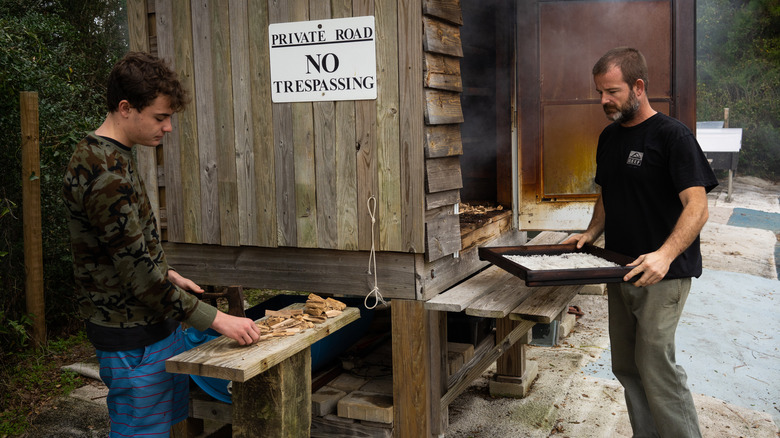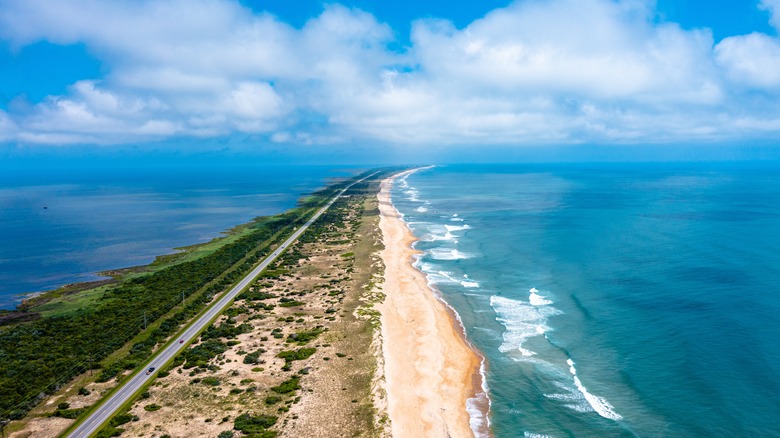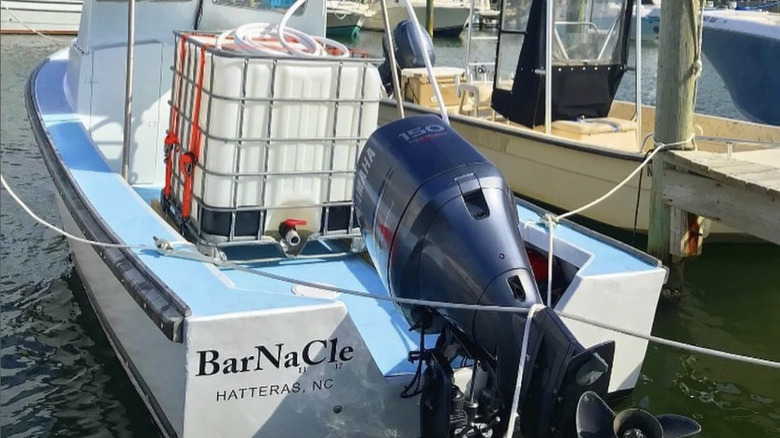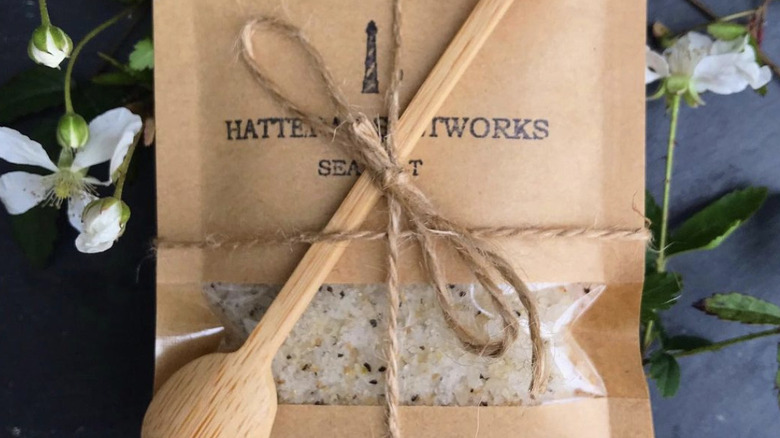The North Carolina-Based Company Making Salt Unlike Any Other
We know the finely ground "white stuff" isn't our only salt option. From Himalayan pink to Celtic gray, Hawaiian black, kosher, flake, smoked, and pickling salts, a dizzying array of salty options travel the globe to season our meals. But there's a homegrown undercurrent of salt-making families in America still creating simple, artisan, small-batch sea salt using solar power alone – simply the sun and sea water hauled in by buckets. Some use solar-heated ovens and wind power to speed the drying process, and many mix their salts with organic dried herbs for flavoring.
But one family saltworks team on windswept Hatteras Island benefits from a dynamic current-fueled phenomenon straight from Mother Nature. It "happens nowhere else on earth," according to hands-on husband-and-wife owners Brian McMahon and Shaena Mullaney. It results in salt like no other as well, harboring a flood of healthy minerals from high-salinity waters lapping the shores of North Carolina's Outer Banks (OBX) –– particularly in the Sargasso Sea waters around Hatteras Island. From intriguing oceanic currents to evaporation hoop houses, a boat named "BarNaCle," and a lot of hard work, Hatteras Saltworks carves out a comforting niche in artisanal sea-salt production.
Salters and the sea
The family's sea-swarthy stories unfold over many chapters, incorporating the U.S. Coast Guard, world-famous Fluer de Sel salt from France, and years of experimental salt-centric travel in the Caribbean, Hawaii, Mexico, and Nicaragua. It all culminates in earthy brown bags of pure, healthy salt from the sea – with options for spicy, smoky, or aromatic seasonings.
Landing on Hatteras Island with the U.S. Coast Guard in 2000, McMahon dove into water operations, repairing and positioning vulnerable buoys, lights, and beacons affected by shifting shoals. Along with his wife, Shaena, and son, Declan, the family fell in love with life in the relatively isolated and somewhat wild Outer Banks. After moving on in 2004, the Carolinas' siren song never went silent, drawing them to distant seas where they mastered the art of drawing, evaporating, and drying salt over years of travel.
After returning to the OBX in 2014, they launched Hatteras Saltworks. Sea mysteries awaited, including the astounding natural anomalies tied to the Gulf Stream and the warm Labrador Current, which happen to collide in the waters of Cape Hatteras. The resulting currents give the thin barrier island its quirky elbow-shaped landform. When those currents merge, the Gulf Stream shoots straight out to sea and rushes toward Brittany, France, home to the renowned Fluer de Sel sea salt, explains McMahon and Mullaney. Likewise, the salty waters on their end of the currents contribute to McMahon's conviction that "pure nutrient-rich waters make pure nutrient-rich ocean salt."
Making sea salt the Hatteras way
The couple navigated a few "storms" when developing the method for their exclusive Hatteras salts. First, regulations prohibited water hauling across island beaches, leading to pier-access deals for pure ocean water involving pumps, pipes, and waiting trucks. Next was seeking agreements with other seaside communities in the OBX, but summer tourism hindered water harvesting during peak solar evaporation months. Then, finally, came the "BarNaCle" boat, christened as a clever nod to sodium chloride (NaCl), the chemical name for salt, as well as to the sticky little "barnacle" crustaceans familiar to most boat owners.
"BarNaCle," an aging SISU Navy boat from Norfolk, Virginia, had no deck and a rotten stern, but the saltmakers exhaustively brought her back to life. She now cruises through Hatteras Inlet, subject to high tides and favorable winds, while negotiating sandbars, trees, sea life, and myriad unexpected encounters, all while collecting the pristine source water for Hatteras salt. NOAA explains how the Sargasso Sea, which resides completely within the Atlantic Ocean and is the world's only sea without a single land border, is home to migrating humpback whales, porbeagle sharks, endangered eels, and way more.
Less than ten years ago, the owner's early salt-making days included constructing equipment from recycled materials, using homes that crumbled into the ocean. They've now settled on hoop houses to evaporate the salt, similar to greenhouses but holding sea-salt ponds inside. Solar ovens complete the drying process.
The salty end result, with creative customizing
From solar ovens to dinner tables, there's only the packaging in between, unless it's the Hatteras salts set aside for seasoning or smoking. A favorite is the six-hour smoked pecan-wood sea salt, while earthy seasonings define other salt packets, including ginger, lavender, garlic, lemon pepper, and rosemary. It's all done in-house on the island, from sea to solar to supper table.
According to the swashbuckling history and spirit of the Outer Banks, sailors and traders once used the infamous Gulf Stream currents off Hatteras Island as trading routes between the Caribbean, Europe, and America. But sea-swarthy pilfering pirates notoriously robbed the inexperienced sea merchants as they wove through the channels and tumultuous currents. Fortunately, getting your hands on valuable goods such as sustainably-produced, mineral-rich sea salts is a bit easier now.
Hatteras Saltworks has a large presence in the Outer Banks and throughout North Carolina, but their all-American sea salts are also available online. You can even keep things pure and aesthetically awesome with the company's cute little 3.5-inch bamboo sea salt spoons.




